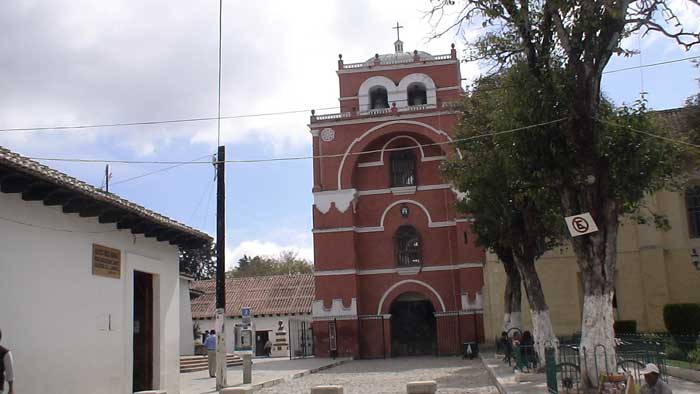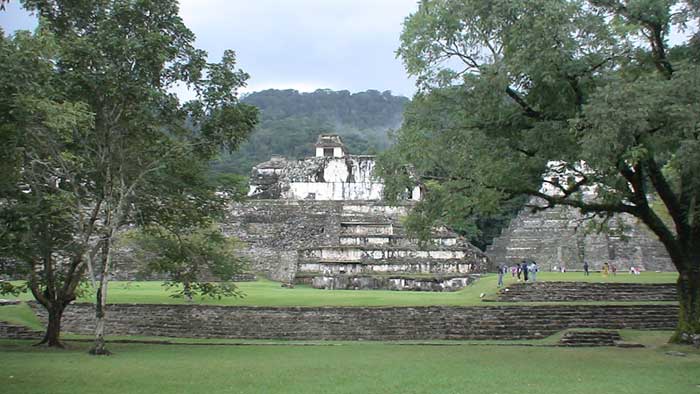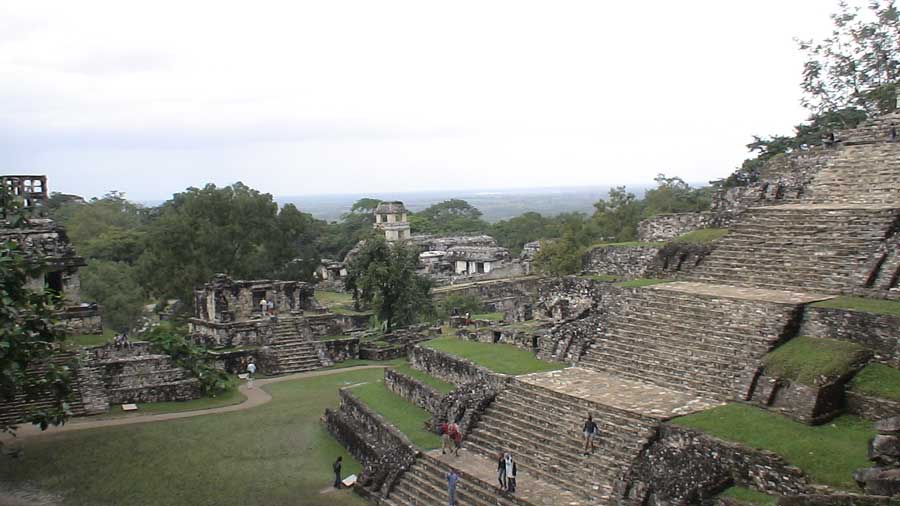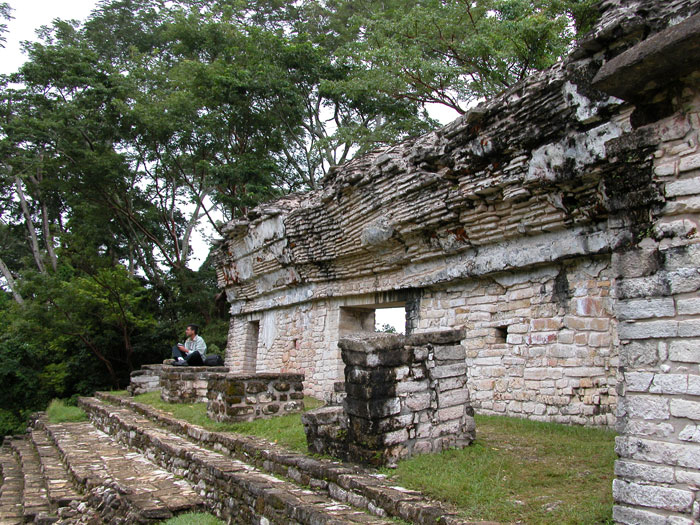
| Previous Page . . . | Continue to Part 2 . . . |
 |
| Monte Alban, the capitol of the Zapotecs and just a few kilometers west of Oaxaca. Here you are overlooking the gran plaza and various temples, tombs and residential complexes. First settled in 500BC, this is one of the oldest cities in the Americas. |
 |
| Templo and Ex-Convento de Santo Domingo, San Cristobal de Las Casas. Built in the 16th century and just one of the ancient and baroque structures around San Cristobal. A lively market takes place in the surrounding area. |
 |
| Torre del Carmen tower, built in 1680. You can see the tower from the end of the promenade when you are coming from the market. |
     |
| The Mayan City of Palenque, Chiapas. I had a wonderful time exploring the area with Linghua. Rising supreme in the middle of a vast jungle with spectacular views of the foothills around, Palenque captures the grandeur of Mayan architecture like no other. The Palace has been carefully excavated and many of the designs on the tombs and temples are well preserved. "First occupied in 100BC, Palenque reached its peak about 700 years later." For more information check out the website made by some of the archeologists working there: http://mesoweb.com/palenque |
 |
| Thanks to Linghua for the pic. |
I had never even heard of Oaxaca before, but many travelers said that it was the center of art in Mexico with a hip educated vibe. I looked at the map and saw that it was on the way to Chiapas, so I decided to take a break from the hectic pace of Mexico City and head to a smaller locale. I stayed at the immaculate Hostal Paulina, run dormitory style and very efficient. It was here I met Fabian and his older brother from France. The three of us traveled to Monte Alban. Chain smoking their way through conversations and speaking in Spanish, they alerted me to the splendor of Agua Azul and Palenque. The older of the French brothers was studying mathematics in Puebla, and the younger one was still in high school. It was a swerving bus ride up a mountain to Monte Alban, the ruins of the first planned city in the Americas. “Monte Alban was the center of a highly organized, priest dominated society, controlling most of what is now Oaxaca.” The city was dominated by the Zapotecs but there are some earlier Olmec influences. The ruins have a logical layout full of temples and pyramid style structures. Dances, ball games and astronomical observations made from the observatory were part of the daily life in Monte Alban. Monte Alban means “white mountains” but previous names from the Zapotecs and Mixtecs where “Sacred Mountain” and “At the Foot of the Sky.” You can look out over the valley and see the entire city of Oaxaca nestled below. The bus cost 30 pesos and entry was another 38 pesos. Oddly enough on the way down the mountain, I saw Nic and her friend Leisel passing on the bus driving up, a wisp of blond hair and white teeth; but my hands could not pry the window open fast enough to say hello. Oaxaca reminded me a little of Santa Barbara in California, with its mission style architecture and festive atmosphere. The city is full of cobbled streets and plazas. Laid out in a similar fashion to the Centro Historico in Mexico City, a Zocalo forms the center with many streets, churches and foot paths sprouting radially in all directions. The Zocalo stands beside a massive Cathedral and contains a park with numerous expensive restaurants that cater to the tourist crowd. The beautiful rhythm of exploring the Oaxacan streets can reward the senses in different ways. You might find a wide staircase leading to a bazaar that turns into food market. Regard all sorts of meats and vegetables, a booth dedicated to Chiapas chocolate, small handmade purses and pouches, a round table where the locals pick and choose their food. As you climb your way up the stairs you turn to stare at the crumbled façade of a cathedral beside a small gallery or art store. Art and craft sellers sell their wares most anywhere, and some of the dresses in particular have very elegant designs. New Year’s Eve we spent in a small bar that Nic and Leisel had found and drank and danced the whole night. In the bar we talked for quite a while with a family who lived in Oaxaca comprised entirely of females, four daughters (3 of whom were there) and their mother. They prompted us to drink mezcal, a strong spirit made from the agave plant, and we ordered margaritas and pina coladas. I could not keep up the pace of drinking with Nic and Leisel, both from London, who ordered corona after corona. The bar manager passed around a bucket filled with live scorpions and said to put it in the mezcal. I looked into the bucket and saw a mass of brown insect legs and stingers and deferred. We danced for a long time, the 18 year old twin sisters danced the most, with the mother jerkily shaking her head and laughing. I was tired by 1 AM, but Nic and Leisel would have gone on longer. I felt sorry that I could not share their conviviality. We ended the night with an interesting conversation with the bar manager, who had lived all over the world and described the village where he was born in Oaxaca. He grew up in a matriarchy where the women owned all the land and had the power. Men were used only for sex and wore white shirts and black pants and lived under the umbrella of the women, somewhat passive and docile. The woman wore great big gold chains and wide skirts. We were all intrigued by this town, and the bar manager said he would give us the address to his house in the village. I enjoyed the company of Leisel and Nic and was grateful for sharing the New Year with them. But by the next day I had had enough of Oaxaca and wanted to move on to Chiapas. When I left the hostel, I reached a Zen-like state of social interaction. I must have spoken lengthily with half a dozen travelers, enjoying meaningful and educational conversations about experiences and history. I wrote down everyone’s email address, and was puzzled why sometimes I can hit it off grandly with people and other times I feel like a stranger. Later when I was on the bus to San Cristobal, I found it difficult to hold a conversation with anyone. San Cristobal de Las Casas is a misty town in the middle of forested mountains and maize fields. The town is much smaller than Oaxaca and the now familiar Zocalo contains a cathedral and plaza. Madre Tierra serves up some excellent Mexican and continental food, even lassis. While having dinner there I saw groups of girls disappearing behind a red curtain in the corner of the patio. After inquiring, I learned that the restaurant shows peliculas (movies) every evening. Most of the movies don’t have English subtitles but I was pleased to see a wide selection, including a documentary about the Zapatistas, “Born into Brothels,” a film about the brothels in Calcutta, Frida, a documentary about Guatemala and Habana Blues. After having a set meal of vegetable soup and rice with frijoles and platanos, I also got the guacamole, which I had been having almost everyday and I couldn’t seem to get enough of. I realized I was spending more money on food than rooms. San Cristobal is colder than Oaxaca, but still has a vacation atmosphere. Since I was backpacking with the desire to learn about the culture and geography of a country, an ambiance of fancy restaurants and trinket shops bored me. I stayed at the Posada Jovel, close to the center of town and first on the budget list in the guide book. So far I had been fairly happy with the accommodations in Mexico. It seemed for about $10-12, you have access to clean private rooms with decent space. I returned to my yoga practices in the morning and evening, after missing it for a couple of days and doing half hearted attempts on the bus. My body thanked me. One place I visited that I had mixed feelings about was San Juan Chamula, a town outside San Cristobal. Chamula is famous for a church where the locals perform their worship with incense, chicken bones, and pictures of saints over a pine needle floor. Here is just one example of how Christian practices are woven with older indigenous customs. The textile shops and market have a wide variety of colorful, if not artistic things to purchase. The town seems to be put up a façade for the tourists, admission to the church was by paid ticket, and for some reason it all seemed artificial. I stayed an extra day in San Cristobal to rest, do laundry and catch up on reading about the area. Compared to the places I had been so far, San Cristobal had the best eating establishments and restaurants. There were numerous natural food shops, vegetarian restaurants and organic goods available for sale. Nacho explained to me that this was because of the Zapatista movement and their desire to promote local economy and organic farming. What can I say about meeting Ignacio "Nacho?" I met him at one of the most unlikely of places and I don’t know who was more lucky. I walked to the bus station to purchase my ticket for Palenque. I saw a curious man sitting cross legged outside the bus station dressed in white. Then he took out a pair of Indian cymbals and started singing bhajans! On closer inspection, I saw that he wore a dhoti tied in the Hare Krishna style and sported long hair with a trident beard. I only wanted to ask him where he had learned his songs, but I quickly found that he spoke excellent English and completed his University degree in psychology and anthropology. In fact, he had been an exchange student in Seattle for one year. I was impressed by his knowledge of India and the indigenous cultures of Mexico. I offered to buy him dinner, which he accepted. He told me that had been caught by the police for smoking marijuana and had given all of his money away as a bribe. We talked for an hour or so in a pizza parlor near the bus station, before his departure to Palenque. I told him it was my birthday the next day and we discussed meeting again. However, my meeting with Nacho was delayed because when I boarded the bus to Palenque the next day, I met another beautiful soul -- Linghua from China. We traveled together on the bus and talked the whole way, huddling close for warmth on the cold bus ride. We stayed in Palenque town and wanted to visit the ruins the following day, but heavy rains delayed us. When we finally made it out, we took a shared taxi to El Panchen and then walked the rest of the distance. Palenque is breathtaking in its scale and immersion in the luscious jungle atmosphere. Leaves and fronds cover the paths, and up on the hills, lush green foliage and trees grow all the way up the very tops of the hills. The palaces and tombs are either white or gray and black stone, with inscriptions and carvings on the walls and inner sanctums. The rain poured down intermittently muddying the ground, but providing a clean and crisp environment. Climbing up the steps of the many edifices gave brilliant views of the whole city and the gentle rolling hills beyond. I was curious how the natives must have been able to find this incredible city even when it was in its peak. Palenque was abandoned after about 900 AD. Some visitors will pray or meditate in the tombs and shrines, or place their hands respectfully over the offering stones. It is quite something else to see the power and scale of an ancient city built to serve an advanced civilization in its prime. The next night we stayed in a cabin at El Panchen, which was nicer and cheaper than a room in town. However, we had to put up with the extra noise and mosquitoes. The music and dancing at El Panchen can go late into the night. The fire dancers were the most extraordinary I had seen since arriving in Mexico. The service sucks at Dos Muchos, and it is difficult to get a table at night since it is so busy. I invited Linghua for dinner on my birthday but we found it difficult to find a table at Dos Muchos. Finally, we talked with a couple from France and Germany and shared a table with them. I began my overlong monologue about my trip to India and being sick which seemed to impress everyone. We talked about our travels and impressions, a well known topic of conversation by now. I also met Lalo, Nacho’s friend and mentor and some of his other friends who sold handmade necklaces and handicrafts. What followed was a surreal evening and night hanging out with Nacho and his friends, “noches interminables en Palenque.” Everyone was smoking weed or cigarettes. Nacho said that he had eaten mushrooms and interested (bored?), I asked if I could try some too. I ate a big mushroom coated in honey that looked harmless enough. The trip was quite mild. I remember seeing reptilian patterns in the sky and the forest. Lights were laced with kaleidoscope outlines. Mauricio, the manager of the campgrounds, was drinking a lot of beer and started to behave unpredictably. Two girls from Australia broke into the conversation at times, constantly moving around with candles. Loud music piped through from someone’s closed door. There was a couple from Argentina and Habib, a Christian Palestinian living in Israel, who appeared frequently from the shadows. Some people were speaking about love or philosophy or beautiful countries. Nacho was lecturing a German guy about the childishness of atheism. People filtered in and out of the patio, a body replacing another. Nacho smoked cigarettes and passed around hashish while others rolled their own joints. I didn’t want to smoke, but when I walked to the front entrance Mauricio handed me a beer and a corn tortilla filled with guacamole. In the same area security guards with guns drank beer and mezcal while cooking dinner. We stood around the cooking fire and exchanged a few words. I don’t know what else happened that night, but morning finally dawned. Nacho was already awake so I quickly brushed my teeth by the sink. No one noticed us leave. |
Movie Clip
Please press play
San Cristobal main market; San Juan Chamula, where the indigenous people mix their own customs with Catholicism; and Palenque. |
| Continue to Part 2 . . . |